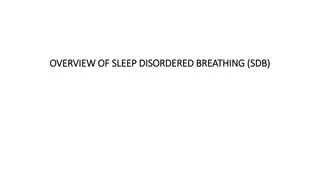Chronic Pain and Sleep: Understanding the Impact of Melatonin
Issues with sleep are common in patients with chronic pain. This study explores the efficacy of Melatonin in improving sleep disturbances and pain intensity in a diverse chronic pain population. Findings suggest a bidirectional association between sleep and pain, emphasizing the importance of addressing sleep quality in chronic pain management.
Download Presentation

Please find below an Image/Link to download the presentation.
The content on the website is provided AS IS for your information and personal use only. It may not be sold, licensed, or shared on other websites without obtaining consent from the author.If you encounter any issues during the download, it is possible that the publisher has removed the file from their server.
You are allowed to download the files provided on this website for personal or commercial use, subject to the condition that they are used lawfully. All files are the property of their respective owners.
The content on the website is provided AS IS for your information and personal use only. It may not be sold, licensed, or shared on other websites without obtaining consent from the author.
E N D
Presentation Transcript
Chronic Pain and Sleep Chronic Pain and Sleep Issues with sleep are common in patients with chronic pain, and sleep disturbance is worse in those with higher pain scores (Fig 1) . Sleep disturbance increases the suffering, disability, and perception of pain. The lack of sleep and poor sleep quality has been found to be a risk factor for the development of chronic pain There is a bidirectional association between sleep and pain. Adam R, Kanakarajan S, Onyeakazi U, Columb MO, Galley HF. BMJ Open 2020; 10: e034443.
MELATONIN MELATONIN Melatonin is naturally occurring hormone and known for its effects on the sleep-wake cycle. It also has anti-inflammatory properties. In UK, CircadinTM islicensed at a dose of 2mg for the treatment of primary insomnia in people over 55 years. In animal pain models, exogenous melatonin has been found to have beneficial effects on nociception, hyperalgesia and pain behaviour.
OBJECTIVE AND OUTCOMES OBJECTIVE AND OUTCOMES Melatonin should improve sleep disturbances in chronic pain patients. Primary outcome - Decrease in sleep disturbance in participants at 6 weeks Secondary outcomes Effect on sleep latency, sleep efficiency, sleep quality, sleep duration Effect on pain intensity Effect on Actigraphy daily pain and fatigue scores Changes in melatonin levels (to rule out hang over effects)
STUDY DESIGN and timeline STUDY DESIGN and timeline Double blinded, randomised, cross over trial to evaluate the efficacy of Melatonin in diverse chronic pain populationover trial to evaluate the efficacy of Melatonin in diverse chronic pain population
SAMPLE SIZE SAMPLE SIZE Powered for both sleep disturbance and Pain Sleep disturbance VSH score difference of 120 (80% power; effect size 0.6) 46 patients Pain score difference of 2 on 11 point NRS at 80% power 23 patients
INCLUSION AND EXCLUSION CRITERIA INCLUSION AND EXCLUSION CRITERIA INCLUSION CRITERIA EXCLUSION CRITERIA Malignant pain Pain score below 7 Aged under 18 Liver function above normal range Concomitant treatment with nifedipine or fluvoxamine, benzodiazepines or non- benzodiazepine hypnotics (zaleplon, zolpidem and zopiclone), History of drug/alcohol abuse, post-traumatic stress disorder or use of psychotropic medications, AWI patients with known hypersensitivity to the drug product or/and any of its excipient. Any subject who is pregnant, breastfeeding or planning to get pregnant Non-malignant pain of more than 3 months duration Average pain score of 7 or more on the BPI scale of 0 to 10, Aged 18 or over No expected change in medication during the trial Normal liver function.
COVID COVID 19 modifications 19 modifications Remote consenting and visits Dropped participant facing activities - blood test, Psychomotor Vigilance Testing (after 18 patients) Questionnaires and Actiwatches were dropped off/ picked up from participant s homes
CONSORT CONSORT For RCT For RCT-- Cross over trial Cross over trial
Baseline characteristics Baseline characteristics Group A Group B Melatonin first Placebo first (n=30) (n=28) Pain Type: Nociceptive/mainly nociceptive 15 11 Neuropathic/ mainly neuropathic 7 11 8 6 Mixed Pain Location Neck 3 1 Thorax, upper back or abdomen 2 3 7 10 Upper or lower limbs 7 9 Low back pain 11 5 Widespread pain
Baseline characteristics Baseline characteristics Group A Group B Melatonin first Placebo first (n=30) 62 [24 -79] (n=28) 55 [28 -79] Age, y (%) Sex, n (%) Male 10 (33%) 12 (43%) Female 20 (67%) 16 (58%) Pain duration, months 96 [12 - 336] 96 [24 - 480] Ethnicity, n (%) White 28 (93%) 27 (96%) Other White 1 (3%) 0 Asian 1 (3%) 0 Black 0 1 (3.6%) Smoking status, n (%) Never smoked 10 (33%) 15 (55%) Ex-smoker 13 (43%) 9 (32%) Smoker 7 (23%) 4 (14%) Body mass index, kg/m2 29.8 [22.7 - 51.3) 30.3 [20.4 48.0] Data are shown as number or median [range] as appropriate, with % in parentheses.
BASELINE OUTCOME MEASURE BASELINE OUTCOME MEASURE Group A Group B Sampling probability Melatonin first Placebo first Verran, Snyder-Halpern sleep scale Sleep disturbance 481 [67-632] 409 [122-673] P=0.06 Sleep latency 89 [4-100] 50 [0-100] P=0.18 Wake after sleep onset 54 [3-100] 43 [0-90] P=0.24 Data shown as median [range]
BASELINE BASELINE OUTCOME OUTCOME MEASURE MEASURE Group A Group B Sampling probability Melatonin first Placebo first Brief Pain Inventory Pain intensityscore 7 [7-10] 7 [7-10] P=0.38 Sleep interference score 8 [1-10] 8 [5-10] P=0.86 Psychological interference score 17 [0-30] 17 [3-28] P=0.75 Pittsburgh Sleep Quality Index Global Score 12.5 [4.0-17.0] 12.0 [5.0-16.0] P=0.31 Sleep duration (hours) 5.0 [2.0-7.5] 2.0 [2.0-8.0] P=0.56 Pain and Sleep Quality 3-Item score 248 [57-300] 214 [83-299] P=0.08 Data shown as median [range]
RESULT RESULT --SLEEP DISTURBANCE SLEEP DISTURBANCE -- VSH VSH Sleep disturbance score was not different between melatonin and placebo at 6wk but fell transiently during melatonin treatment
RESULT RESULT-- SLEEP LATENCY AND WASO SLEEP LATENCY AND WASO Sleep latency WASO Transient effects on other sleep parameters including sleep latency and wake after sleep onset (WASO) were also seen during the melatonin treatment period.
P=0.032 A 300 RESULT RESULT-- PSQ PSQ--3 AND 3 AND PSQI SCORES PSQI SCORES 250 PSQ-3 Total Score 200 150 100 50 0 P<0.001 P<0.001 P=0.004 B 20 15 PSQI Global Score 10 5 0 P<0.001 P<0.001 Baseline 3 weeks 6 weeks Melatonin period Placebo period PS3-3 and PSQI sleep quality scores decreased significantly after 3- and 6-weeks melatonin treatment with a significant difference between melatonin and placebo treatment periods at 3 weeks
RESULT RESULT-- PAIN INTENSITY PAIN INTENSITY The average pain intensity scores captured by the BPI decreased during both treatment periods
ACTIWATCH PAIN AND FATIGUE ACTIWATCH PAIN AND FATIGUE SCORE SCORE Actiwatch pain and fatigue data showed very small, but significant, overall reduction during melatonin treatment compared to placebo treatment
Blood sampling Blood sampling There was no difference in circulating melatonin levels during the melatonin or placebo treatment and no change during treatments
ADVERSE EVENTS ADVERSE EVENTS Number of adverse events Melatonin Placebo Total during treatment period period Event Headache Drowsiness Nightmares Infections Mental health issues Gut problems Skin problems Joint problems Other 8 1 1 12 2 4 22 3 19 6 4 24 4 1 3 11 2 10 5 2 11 11 1 9 1 2 13 47 96 Total 49 Adverse events were similar during Melatonin and placebo periods
CONCLUSION CONCLUSION Treatment with 2mg melatonin did not improve sleep disturbance at 6 weeks Transient beneficial effects at 3 weeks were noted in all sleep parameters. During trial participation, patients with chronic pain reported lower pain intensity scores.
ACKNOWLEDGEMENT ACKNOWLEDGEMENT We are grateful to the BJA/RCoA for funding and Flynn Pharma for providing trial drugs
QUESTIONS? QUESTIONS?


